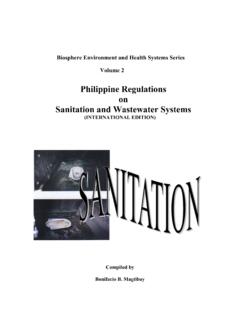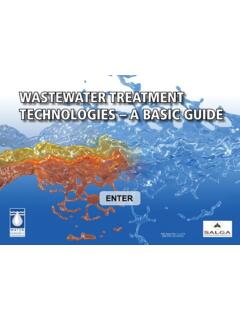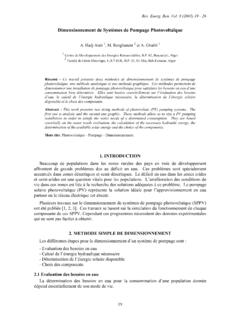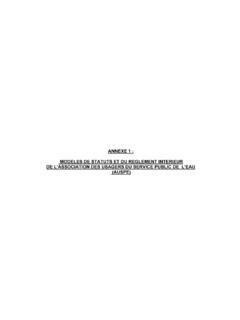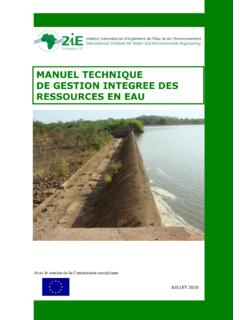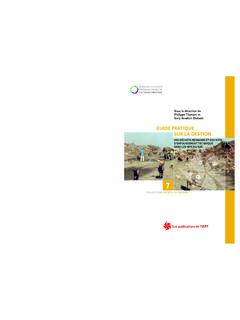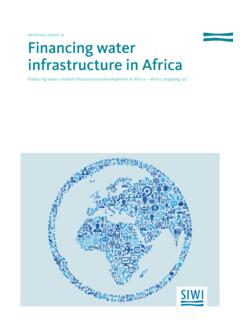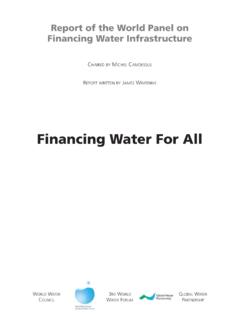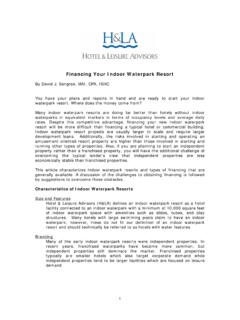Transcription of TOOLS AND APPROACHES - pseau.org
1 OECD Studies on WaterMeeting the Challenge of financing water and SanitationTOOLS AND APPROACHESP lease cite this publication as:OECD (2011), Meeting the Challenge of financing water and Sanitation: TOOLS and APPROACHES , OECD Studies on water , OECD Publishing. work is published on the OECD iLibrary, which gathers all OECD books, periodicals and statistical databases. Visit , and do not hesitate to contact us for more :HSTCQE=VWUZV]:ISBN 978-92-64-12051-897 2011 14 1 POECD Studies on WaterMeeting the Challenge of financing water and SanitationTOOLS AND APPROACHESW ater is essential for economic growth, human health, and the environment. Yet governments around the world face significant challenges in managing their water resources effectively. The problems are multiple and complex: billions of people are still without access to safe water and adequate sanitation; competition for water is increasing among the different uses and users; and major investment is required to maintain and improve water infrastructure in OECD and non-OECD countries.
2 This OECD series on water provides policy analysis and guidance on the economic, financial and governance aspects of water resources management. These aspects generally lie at the heart of the water problem and hold the key to unlocking the policy I. Key issues with respect to financing water and sanitationChapter 1. What are the benefits of investing in water and sanitation services?Chapter 2. Current status of water and sanitation services and investment needsChapter 3. Where is the money going to come from?Part II. A toolbox to support effective water and sanitation policiesChapter 4. Introduction to the toolboxChapter 5. Strategic financial planning for water and sanitation services at national or regional level: The FEASIBLE toolChapter 6. Financial planning tool for water utilitiesChapter 7. Multi-year investment planning tool for municipalitiesChapter 8. Guidelines for performance-based contractsChapter 9. water utility performance indicators (IBNET)Chapter 10.
3 Private sector participation in water infrastructure: Checklist for public actionOECD Studies on water Meeting the Challenge of financing water and SanitationCo-distributed byIWA PublishingAlliance House, 12 Caxton Street,London SW1H OQS, UKTelephone: +44 (0) 20 7654 5500 Fax: +44 (0) 20 7654 5555E-mail: Studies on WaterMeeting the Challenge of financing water and SanitationTOOLS AND APPROACHESThis work is published on the responsibility of the Secretary-General of the opinions expressed and arguments employed herein do not necessarily reflectthe official views of the Organisation or of the governments of its member document and any map included herein are without prejudice to the status ofor sovereignty over any territory, to the delimitation of international frontiers andboundaries and to the name of any territory, city or 978-92-64-12051-8 (print)ISBN 978-92-64-12052-5 (PDF)Series: OECD Studies on WaterISSN 2224-5073 (print)ISSN 2224-5081 (online)Photo credits: Cover From left to right Taro Yamada/Corbis, iStockphoto/Roger Whiteway, iStockphoto/Carmen Mart nez Ban s, iStockphoto/Mark TenniswoodCorrigenda to OECD publications may be found on line at.
4 OECD 2011 You can copy, download or print OECD content for your own use, and you can include excerpts from OECD publications, databases and multimedia products in your own documents, presentations, blogs, websites andteaching materials, provided that suitable acknowledgment of OECD as source and copyright owner is requests for public or commercial use and translation rights should be submitted to for permission to photocopy portions of this material for public or commercial use shall be addresseddirectly to the Copyright Clearance Center (CCC) at or the Centre fran ais d exploitation dudroit de copie (CFC) at cite this publication as:OECD (2011), Meeting the Challenge of financing water and Sanitation: TOOLS and APPROACHES ,OECD Studies on water , OECD THE CHALLENGE OF financing water AND SANITATION TOOLS AND APPROACHES OECD 2011 FOREWORD 3 ForewordAlmost 900 million people cannot get clean drinking water and billion lack access to basic sanitation.
5 Polluted water and poor sanitation cause million preventable child deaths per year which makes them among the biggest causes of infant mortality along with malaria and malnutrition. This book Meeting the Challenge of financing water and Sanitation presents strategies on how finance for essential water and sanitation services can be mobilised. And it offers a set of concrete policy TOOLS that governments can use to support these efforts. Improving water and sanitation infrastructure will require a significant scale-up in funding in both developed and developing countries. For example, it is estimated that the US will have to invest USD 23 billion annually for the next 20 years to maintain water infrastructure at current service levels, while meeting health and environmental standards. Meanwhile, in developing countries, current spending will need to double to about USD 18 billion per year, to expand water services and achieve the water and sanitation Millennium Development Goals.
6 In addition, investment will be needed to maintain the existing water infrastructure in these countries, which will add another USD 54 billion spending per benefits of improved water and sanitation are massive. One dollar of investment in water and sanitation saves 4 to 12 dollars in avoided health care costs alone. African governments and G8 leaders have both recognised the challenges and committed themselves to supporting a more strategic approach as well as to the mobilisation of more financial resources. Closing the significant gap between the funding that is currently available and the investment that is needed will require significant efforts by governments and the private sector around the world. In this context Meeting the Challenge of financing water and Sanitation provides support for these policy efforts based on ongoing OECD work and cross-country evidence from the experiences of both developing and developed countries.
7 One of the most under-utilised opportunities for reducing the funding gap comes from improving the efficiency of the water and sanitation sector. MEETING THE CHALLENGE OF financing water AND SANITATION TOOLS AND APPROACHES OECD 20114 FOREWORDThis report shows how governments can implement the necessary reforms, and establish more sustainable financing for the sector relying on three basic sources of revenue - the 3Ts ( taxes, tariffs and transfers). It also highlights how countries can mobilise repayable finance, including through innovative mechanisms such as grouped financing vehicles and , there is an urgent need for governments to think more strategically about the water sector. Strategic financial planning assists governments to set realistic infrastructure targets that can be achieved with available resources and that are agreed in a multi-stakeholder policy dialogue. Heeding this message will go a long way towards ensuring adequate financing for the water sector and will improve the lives of millions of people around the world.
8 The OECD stands ready to help!Angel Gurr aOECD Secretary-GeneralMEETING THE CHALLENGE OF financing water AND SANITATION TOOLS AND APPROACHES OECD 2011 ACKNOWLEDGEMENTS 5 AcknowledgmentsThis report was prepared by Sophie Tr molet (Tr molet Consulting, UK) with inputs from Peter B rkey, C line Kauffmann and Alexandre Martoussevitch from the OECD secretariat in Paris. It draws on a number of recent OECD publications, including Managing water for All: An OECD Perspective on Pricing and financing (2009), Strategic Financial Planning for water Supply and Sanitation (2009), Private Sector Participation in water Infrastructure. OECD Checklist for Public Action (2009), Pricing water resources and water and sanitation services (2010a), Innovative Finance Mechanisms for the water Sector (2010b) and Benefits of Investing in water and Sanitation: an OECD Perspective (2011).Several experts from the OECD secretariat contributed inputs into Part II of the report, including Val rie Gaveau (Development Cooperation Directorate), C line Kauffmann (Directorate for Financial and Enterprise Affairs), Tatiana Efimova, Nelly Petkova and Alexander Martoussevitch (all Environment Directorate).
9 Jim Winpenny (Wynchwood Consulting) contributed inputs into the design of the work, while Diane Binder (Tr molet Consulting) carried out initial research as well as editing for Part II. Finally, the authors are grateful to Peregrine Swann (WHO) for his comments and report was discussed and declassified by the OECD Working Party on Biodiversity, water and Ecosystems at its meeting in March THE CHALLENGE OF financing water AND SANITATION TOOLS AND APPROACHES OECD 2011 TABLE OF CONTENTS 7 Table of contentsAbbreviations and acronyms ..11 Executive summary .. 13 Introduction .. 21 Overview .. 21 Structure of the report .. 22 Part I. Key issues with respect to financing water and sanitationChapter are the benefits of investing in WSS? .. Identifying necessary investments in WSS .. Estimating the benefits of investing in WSS..31 Chapter status of WSS and investment needs .. Current status and investment needs in OECD countries and transition economies.
10 Overview of investment needs in developing countries: Reaching the MDGs .. 45 Chapter is the money going to come from?.. Reducing costs and improving efficiency .. Closing the gap: A combination of the 3Ts .. Bridging the gap: Tapping repayable sources of funding .. Mobilising the private sector .. Using strategic financial planning.. 79 MEETING THE CHALLENGE OF financing water AND SANITATION TOOLS AND APPROACHES OECD 20118 TABLE OF CONTENTSPart II. A toolbox to support effective water and sanitation policiesChapter to the toolbox.. 89 Chapter Financial Planning for WSS at national or regional level the FEASIBLE tool .. Background and rationale .. Description of the Strategic Financial Plan process and the FEASIBLE tool .. Where has it been applied? .. Lessons learned and the way forward .. How to get started? ..101 Chapter planning tool for water utilities .. Background and rationale for developing the tool .

